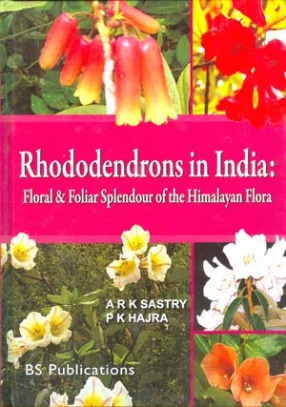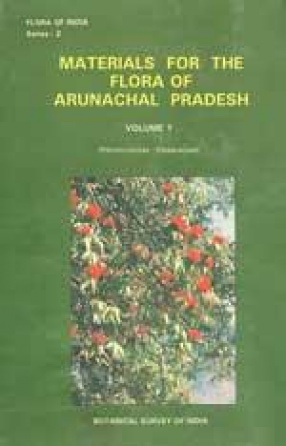
P.K. Hajra

Showing all 22 books






The Genus Rhododendron is acclaimed in horticulture for its most elegant, bell-shaped flowers of varied colours. In India, Rhododendron species are found in the Himalayas from Kashmir to Arunachal Pradesh and in the forested mountain tracts of N.E. Indian states. The interest in the Himalayan Rhododendrons began with the discovery of the red flowered R. Arboreum in Kashmir in the year 1796 and introduction of its seeds into the English Gardens in 1827. J.D. ...

The first volume in this series has already been published which contains valuable information on different recognised groups of non-flowering plants and Gymnosperms. Volume II and III are devoted to the Biodiversity of flowering plants occurring in different Phytogeographical regions of India. These volumes capture the enormous floristic diversity, their utility and status. Numerous illustrations and coloured pictures have been added to enhance the scientific ...

Arunachal - the land of the rising sun, in the extreme north-eastern corner of India covers an area of 83740 sp. km. It lies between 26o 28' and 29o 30' north latitude and 90o 30' and 97o 30' east longitude. It is bounded in the north by Mc-Mohan Line, in the east by China and Burma (Myanmar), in the south by the states of Nagaland and Assam and in the west by Bhutan. Arunachal Pradesh, in the extreme north-eastern corner of the country, harbours a very rich and ...



The current book in six volumes has now been put forth by the Botanical Survey of India. This is probably the world's most voluminous and exhaustive account of floristic diversity published on any area of the world of the size of India. Its publication is very opportune in another respect; it appears in the golden jubilee year of India's independence. It covers several aspects of floristic diversity, its utility and conservation. The various chapters are ...

The Nanda Devi Biosphere Reserve lies approximately between 300 16' to 300 41' N latitude and 790 40' to 800 05 E longitude with a spread of about 2000 sq. km and range of altitude between 1500 m to 5600 m. It is in the Chamoli district of the Garhwal Himalayas of Uttar Pradesh. The Eastern and Southern rims of the biosphere from the border of Chamoli district with Pithoragarh and Almora districts respectively. From the preface:"The basic objectives of the ...

North Eastern India is botanically a very interesting region due to its comparatively less disturbed vegetation. The largest plain land in northeastern India is the Brahmaputra valley. This plain land is of significance not only for agriculture and industry of this region but also for the rich vegetation preserved in many sanctuaries. No detailed account of the flora and vegetation of these sanctuaries is available. Some floristic work for the whole of Assam in ...



India with over 45,000 species of flora and 75,000 species of fauna distributed in its two major biogeographic realms have 10 biogeographic zones and two biodiversity hotspot regions of the world, is justifiably recognized as one of the World's 12 magacentres of biodiversity. Such a richness of varied biomes from tropical wet evergreen forests to deserts and alpine vegetation to coastal systems understandably needed the establishment of a well organized ...


Continuing with the present series on Flora of India, the editors now take pleasure in presenting the volume on Asteraceae, one of the largest flowering plant families in India, comprising about 1052 taxa in 161 genera (excluding the cultivated ones). In view of its large size the treatment is being presented in two volumes, i.e. Volumes 12 and 13. The entire family is treated under 12 tribes, viz. Anthemideae, Astereae, Calenduleae, Cardueae, Cichorieae, ...





The state of Sikkim situated on the flanks of the Eastern Himalayas between 27010' - 28o5' N and 88030' - 890 E is bounded by Nepal in the west, Bhutan in the south-east, Tibet in the north and north-east and the Darjeeling district of West Bengal in the south. The topography of this pretty Himalayan state is varied. The altitudes range from 244 m to over 8598 m. Most of the 7300 sp km area is interlaced with jungle-clad ridges and deep ravines created by, and ...

The first volume in this series has already been published which contains valuable information on different recognised groups of non-flowering plants and Gymnosperms. Volume II and III are devoted to the Biodiversity of flowering plants occurring in different Phytogeographical regions of India. These volumes capture the enormous floristic diversity, their utility and status. Numerous illustrations and coloured pictures have been added to enhance the scientific ...

Many small and large books have appeared on biodiversity in India in the last one decade. This book deals with 'Hotspots' of one major component of biodiversity, the plant resources in selected and critical areas in India. The work is authored by scientists who are researchers by profession and are well trained taxonomists of Botanical Survey of India, which is the main official agency of the Government for study of plant resources of the country. The book covers ...

The book is a humble attempt to provide a handy manual for identification of some indigenous and exotic plants of the valley. The species that are of ornamental value or the ones that have potential of greater popularity are included. Species that are met along roadsides, gardens and scientific institutions have been described along with photographs. The common names in Hindi and English have also been given wherever available. About 118 species have been ...
